Content for TR 26.928 Word version: 18.0.0
0…
4…
4.1.2…
4.2…
4.3…
4.4…
4.5…
4.6…
4.6.7
4.7…
4.9…
5…
6…
7…
8
A…
A.4…
A.7…
A.10…
A.13
A.14
A.15
A.16
A.17
A.18…
6 Mapping Extended Reality to 5G
6.1 Introduction
6.2 XR Processing and Media Centric Architectures
6.2.1 Introduction
6.2.2 Viewport-Independent delivery
6.2.3 Viewport-dependent Streaming
6.2.4 Viewport Rendering in Network
6.2.5 Raster-based Split Rendering
6.2.6 Generalized XR Split Rendering
6.2.7 XR Distributed Computing
6.2.8 XR Conversational
6.3 Summary of Traffic Characteristics
6.4 Analysis of existing 5QIs
...
...
6 Mapping Extended Reality to 5G p. 62
6.1 Introduction p. 62
Based on the technologies introduced in clause 4 as well as the core use cases and scenarios introduced in clause 5, this clause maps a set of core technologies to 5G media centric architectures.
6.2 XR Processing and Media Centric Architectures p. 62
6.2.1 Introduction p. 62
This clause focuses on rendering and media centric architectures. The architectures are simplified and illustrative, they only consider an XR server and an XR device to identify the functions in XR servers and XR devices that communicate and exchange information, possibly over a 5GS communication. The baseline technologies are introduced in clause 4. These architectures focus on processes where the following main tasks are carried out:
- Display
- Tracking and Pose Generation
- Viewport Rendering
- Capture of real-world content
- Media encoding
- Media decoding
- Media content delivery
- 5GS communication
- Media Formats, metadata and other data delivered on communication links
- Spatial Location Processing
6.2.2 Viewport-Independent delivery p. 63
6.2.2.1 Architecture p. 63
In the viewport independent delivery case, following the architecture in clause 4.3 of TS 26.118, tracking and sensor information is only processed in the XR device as shown in Figure 6.2.2-1. This means that the entire XR scene is delivered and decoded.
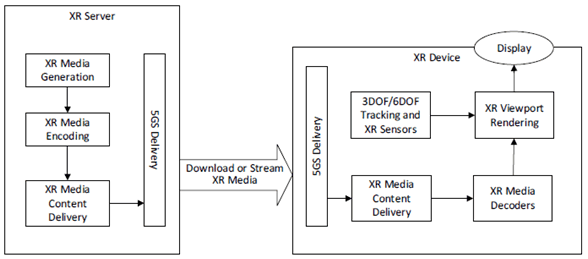
6.2.2.2 Use Cases in Context p. 63
Use cases that may be addressed partially or completely by this delivery architecture are summarized in clause 5.4.
6.2.2.3 Basic Procedures p. 63
The basic procedures follow the procedures of 5G Media Streaming in clause 5 of TS 26.501. Both, on-demand and live streaming may be considered.
6.2.2.4 Content Formats and Rendering p. 63
No content format for 6DoF streaming is fully defined yet, but the content may for example be a scene for which foreground 3D objects, for example represented by point-clouds, are mixed with background content, for example a omnidirectional scene. The combination of the content may be provided by a scene description that places the object in the 6DoF scene. Typically, the data needs to be streamed into buffers that are jointly rendered.
Due to the significant amount of data that needs to be processed in the device, hardware supported decoding and rendering is necessary.
Such an approach typically requires the delivery and decoding of several video and audio streams in parallel.
6.2.2.5 Relevant QoS and QoE parameters p. 63
In the case of viewport-independent streaming, processing of updated pose information is only done locally in the XR device. Delivery latency requirements are independent of the motion-to-photon latency.
In order to provide sufficient content quality, the video material is referably encoded such that the QoE parameters as defined as defined in clause 4.2 can be fulfilled. The necessary QoS and bitrates on the 5G System depend depend on the type of the XR media as well as on the streaming protocol. Based on information from the workshop "Immersive Media meets 5G" in April 2019 as well as from publicly announced demos, that based on today's equipment and the one available over the next 2-3 years, around 100 Mbps are sufficient bitrates to address high-quality 6DOF VR services. This is expected to allow 2k per eye streaming at 90 fps (see clause 4.2) using existing video codecs (see clause 4.5). The QoE requirements may increase further, for example higher resolution and frame rate, but with the advance of new compression tools, this is expected to be compensated.
The XR media delivery are typically built based on download or adaptive streaming such as DASH (see for example TS 26.118 and TS 26.247), such that one can adjust quality to the available bitrate to a large extent.
Suitable 5QI values for adaptive streaming over HTTP are 6, 8, or 9 as defined in clause 4.3.3.
If other protocols are applied for streaming, then suitable 5QIs would be for FFS.
In the context of the present document, relevant 3D media formats, efficient compression, adaptive delivery as well as the perceived quality of the XR media is of key relevance.
6.2.2.6 Potential Standardisation Needs p. 64
In the context of this delivery scenario, the following potential standardisation needs are identified:
- Very high-bitrate and efficient/scalable streaming protocols
- 6DoF Scene Description and XR media integration
- Video and audio codec extensions to efficiently code and render graphics centric formats (2D, meshes, point clouds)
- Support of decoding platforms that support the challenges documented in clause 4.5.2.
6.2.3 Viewport-dependent Streaming p. 64
6.2.3.1 Architecture p. 64
In the viewport dependent delivery case, following the architecture in clause 4.3 of TS 26.118, the tracking information is predominantly processed in the XR device, but the current pose information is provided to the XR delivery engine in order to include the pose information in the adaptive media requests. In an extension to this in the case of XR and 6DoF, the XR pose and additional information may be shared with the XR content delivery in order to only access the information that is relevant for the current viewports. According to Figure 6.2.3-2, the tracking and sensor data is processed in the XR device for XR rendering, and the media is adaptively delivered/requested based on the XR viewport. A reduced or a viewport optimized scene is delivered and also only a reduced scene is processed. Examples include an object that is not visible is not delivered, or only delivered in low quality, or that only the part of the object that is in the viewport is delivered with the highest quality.
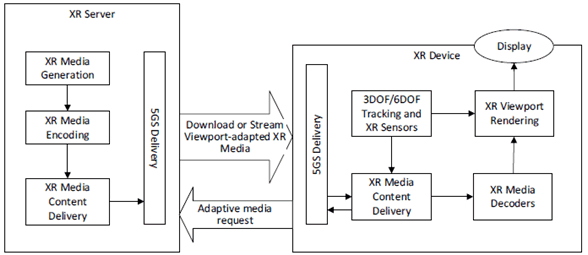
6.2.3.2 Use Cases in Context p. 65
Use cases that may be addressed partially or completely by this delivery architecture are summarized in clause 5.4.
6.2.3.3 Basic Procedures p. 65
The basic procedures follow the procedures of 5G Media Streaming in clause 5 of TS 26.501. Both, on-demand and live streaming may be considered.
In addition, the request for data is accompanied with information from the XR engine.
6.2.3.4 Content Formats and Rendering p. 65
The same formats as discussed in clause 6.2.2.4 apply.
6.2.3.5 Relevant QoS and QoE parameters p. 65
Compared to the viewport independent delivery in clause 6.2.2, for viewport dependent streaming, updated tracking and sensor information impacts the network interactivity. Typically, due to updated pose information, HTTP/TCP level information and responses are exchanged every 100-200 ms in viewport-dependent streaming.
From analysis in TR 26.918 and other experience as for example documented the workshop "Immersive Media meets 5G" in April 2019 [42], such approaches can reduce the required bitrate compared to viewport independent streaming by a factor of 2 to 4 at the same rendered quality.
It is important to note that viewport-dependent streaming technologies are typically also built based on adaptive streaming allowing to adjust quality to the available bitrate. The knowledge of tracking information in the XR Delivery receiver just adds another adaptation parameter. However, generally such systems may be flexibly designed taking into account a combination/tradeoff of bitrates, latencies, complexity and quality.
6.2.3.6 Potential Standardisation Needs p. 65
In the context of the this architecture, the following potential standardisation needs are identified:
- The same aspects as defined in clause 6.2.2.6.
- In addition, more flexible data structures and access to these data structures as well as concurrentdecoding and streaming of smaller units of data, such as tile-based structures, may be defined.
- If other protocols than adaptive streaming over HTTP would be applied, then suitable 5QIs would be for FFS.
6.2.4 Viewport Rendering in Network p. 66
6.2.4.1 Overview p. 66
In a architecture as shown in Figure 6.2.4-1 below, the viewport is entirely rendered in the XR server. The XR server generates the XR Media on the fly based on incoming Tracking and Sensor information, for example a game engine. The generated XR media is provided for the viewport in a 2D format (flattened), encoded and delivered over the 5G network. The tracking and sensor information is delivered in the reverse direction. In the XR device, the media decoders decode the media and the viewport is directly rendered without using the viewport information.
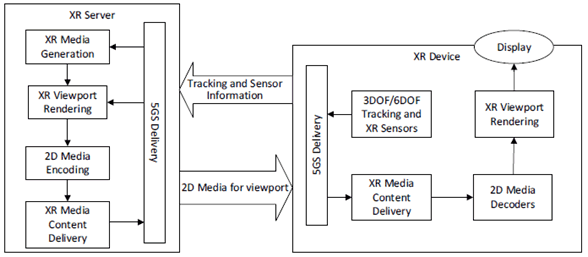
The following call flow highlights the key steps:
-
An XR device connects to the network and XR Media Generation application
- Sends static XR device information and capabilities (supported decoders, viewport)
- Based on this information, XR server sets up encoder and formats
-
Loop
- XR device collects pose (or a predicted pose)
- XR Pose is sent to XR Server
- The XR Server uses the pose to generate/compose the viewport
- XR Viewport is encoded with regular media encoders
- The compressed video is sent to XR Device
- The XR device decompresses video and directly renders viewport
6.2.4.2 Relevant QoS and QoE parameters p. 66
The following three cases, with different media delivery bitrates, are considered:
- Around 100 Mbps: In this case, the XR device needs to perform certain amount of processing and decoding.
- Around 1 Gbps: In this case, only lightweight and low-latency compression (e.g. intra only) may be used to provide sufficiently high quality (4k or even 8k at sufficiently high frame rates above 60 fps) and sufficiently low latency (immersive limits of less than 20ms for motion to photon) for such applications. It is still expected that some processing (e.g. decoding) by the XR device is needed.
- Around 10 Gbps or even more: A full "USB-C like" wireless connection, providing functionalities that currently can only be provided by cable, possibly uncompressed formats such as 8K. The processing requirements for the XR device in this case may be minimal.
6.2.4.3 Potential Standardisation Needs p. 67
On Formats and codecs:
- From the analysis, for case 1, similar aspects as defined in clause 6.2.2.6 apply for the formats.
- For cases 2 and 3, formats are of less relevance for 3GPP as such formats are typically defined by other consortia, if at all.
- Network rendering for cloud gaming on flat screens is expected to be of significant relevance. In this case the end-to-end latency (action to photon) is determined by the roundtrip interaction delay, i.e. 50ms (see 4.5.2). 5QIs to support such latencies as well as guaranteed bitrates are considered of relevance. Required bitrates follow case 1) from above.
-
Network rendering for XR services would require an end-to-end latency including motion-to-photon (including network rendering, encoding, delivery and decoding) of 20ms to meet the immersive limits and it is expected that the bitrates would be higher due to low-complexity and low-latency encoding, following case 2) and 3) from above. Hence,
- 5QIs and QoS would be necessary, that provides significantly lower latency than 10ms in both directions and the same time provides a stable and high bitrate in the range of 0.1 - 1 Gbps according to case 2).
- It is not expected to be practical for Uu-based communication to achieve such low-latencies at very high bitrates (mostly case 3, e.g. 1Gbps and higher) in the short term, but final studies on this matter are FFS.
- However, sidelink-based based communication addressing network rendering is expected to be feasible in the 5G architecture and is subject to active work in 3GPP.
6.2.5 Raster-based Split Rendering p. 67
6.2.5.1 Architecture p. 67
Raster-based split rendering refers to the case where the XR Server runs an XR engine to generate the XR Scene based on information coming from an XR device. The XR Server rasterizes the XR viewport and does XR pre-rendering.
According to Figure 6.2.5-1, the viewport is pre-dominantly rendered in the XR server, but the device is able to do latest pose correction, for example by asynchronuous time-warping (see clause 4.1) or other XR pose correction to address changes in the pose.
- XR graphics workload is split into rendering workload on a powerful XR server (in the cloud or the edge) and pose correction (such as ATW) on the XR device
- Low motion-to-photon latency is preserved via on device Asynchronous Time Warping (ATW) or other pose correction methods.
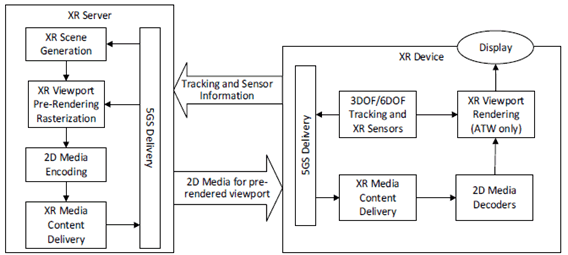
Figure 6.2.5-1: Split Rendering with Asynchronous Time Warping (ATW) Correction
(⇒ copy of original 3GPP image)
(⇒ copy of original 3GPP image)
6.2.5.2 Use Cases in Context p. 68
The use cases in clause 5.5 may be addressed by this architecture.
6.2.5.3 Basic Procedures p. 68
The following call flow highlights the key steps:
-
An XR Device connects to the network and joins XR application
- Sends static device information and capabilities (supported decoders, viewport)
- Based on this information, the XR server sets up encoders and formats
-
Loop
- XR Device collects XR pose (or a predicted XR pose)
- XR Pose is sent to XR Server
- The XR Server uses the pose to pre-render the XR viewport
- XR Viewport is encoded with 2D media encoders
- The compressed media is sent to XR device along with XR pose that it was rendered for
- The XR device decompresses video
- The XR device uses the XR pose provided with the video frame and the actual XR pose for an improved prediction using and to correct the local pose, e.g. using ATW.
6.2.5.4 Content Formats and Rendering p. 69
Rasterized 3D scenes available in frame buffers (see clause 4.4) are provided by the XR engine and need to be encoded, distributed and decoded. According to clause 4.2.1, relevant formats for frame buffers are 2k by 2k per eye, potentially even higher. Frame rates are expected to be at least 60fps, potentially higher up to 90 fps.The formats of frame buffers are regular texture video signals that are then directly rendered. As the processing is graphics centric, formats beyond commonly used 4:2:0 signals and YUV signals may be considered.
6.2.5.5 Relevant QoS and QoE parameters p. 69
With the use of time warp, the latency requirements follow those documented in clause 4.2.2, i.e. the end-to-end latency between the user motion and the rendering is 50ms.
It is known from experiments that with H.264/AVC the bitrates are in the order of 50 Mbps per eye buffer. It is expect that this can be reduced to lower bitrates with improved compression tools (see clause 4.5) but higher quality requirements may absorb the gains. It is also known that this is both content and user movements dependent, but it is known from experiments that 50 - 100 Mbps is a valid target bitrate for split rendering.
Regular stereo audio signals are considered, requiring bitrates that are negligible compared to the video signals.
5QI values exist that may address the use case, such 5QI value number 80 with 10ms, however this is part of the non-GBR bearers (see clause). In addition, it is unclear whether the 10ms with such high bitrates and low required error rates may be too stringent and resource consuming. Hence, for simple split rendering in the context of the requirements in this clause, suitable 5QIs may have to be defined addressing the latency requirements in the range of 10-20ms and bitrate guarantees to be able to stream 50 to 100 Mbps consistently.
The uplink is predominantly the pose information, see clause 4.1 for details. Data rates are several 100 kbit/s and the latency should be small in order to not add to the overall target latency.
6.2.5.6 Potential Standardisation needs p. 69
In the context of this architecture, the following potential standardisation needs are identified:
- Regular 2D video encoders and decoders that are capable encode and decode 2K per eye as well as 90 fps and are capable to encode typical graphics frame buffer signals.
- Pose information in the uplink at sufficiently high frequency
- Content Delivery protocols to support the delivery requirements
- Edge computing discovery and capability discovery
- A simple XR split rendering application framework for single buffer streaming
- New 5QIs and QoS support in 5G System for split rendering addressing latency requirements in the range of 10-20ms and bitrate guarantees to be able to stream 50 to 100 Mbps consistently.
6.2.6 Generalized XR Split Rendering p. 69
6.2.6.1 Architecture p. 69
In Figure 6.2.6-1, an architecture is shown for which the XR server pre-renders the 3D scene into a simpler format to be processed by the device (e.g. it may provide additional metadata that is delivered with the pre-rendered version). The device recovers the baked media and does the final rendering based on local correction on the actual pose.
- XR graphics workload is split into rendering workload on a powerful XR server and simpler XR processing on the XR device
- This approach enables to relax the latency requirements to maintain a full immersive experience as time-critical adjustment to the correct pose is done in the device.
- this approach may provide more flexibility in terms of bitrates, latency requirements, processing, etc. than the single buffer split rendering in clause 6.2.5.
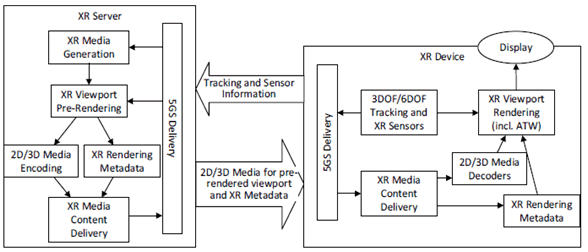
Figure 6.2.6-1: VR Split Rendering with XR Viewport Rendering in Device
(⇒ copy of original 3GPP image)
(⇒ copy of original 3GPP image)
Such an approach needs careful considerations on the formats of projected media and their compression with media decoders. Also important is distribution of latencies to different components of the system. More details and breakdown of the architectures is necessary. The interfaces in the device however are aligned with the general structure defined above.
In general, the similar requirements and considerations as in clause 6.2.5 apply, but a more flexible framework may be considered by providing not only 2D frame buffers, but different buffers that are split over the network.
6.2.6.2 Use Cases in Context p. 70
The use cases in clause 5.5 may be addressed by this architecture.
6.2.6.3 Basic Procedures p. 70
The following call flow highlights the key steps:
-
An XR Device connects to the network and joins XR application
- Sends static device information (supported decoders, viewport, supported formats)
- Based on this information, network server sets up encoder and formats
-
Loop
- XR Device collects XR pose (or a predicted XR pose)
- XR Pose is sent to XR Server
- The XR Server uses the pose to pre-render the XR viewport by creating one or multiple rendering buffers, possibly with different update frequencies
- The rendering buffers are encoded with 2D and 3D media encoders
- The compressed media is sent to XR device along with additional metadata that describes the media
- The XR device decompresses the multiple buffers and adds this to the XR rendering engine.
- The XR rendering engine takes the buffers, the rendering pose assigned to the buffers and the latest XR pose to create the finally rendered viewport.
6.2.6.4 Content Formats and Rendering p. 71
In this context, the buffers may not only be 2D texture or frame buffers as in case of clause 6.2.5, but may include geometric data, 3D data, meshes and so on. Also multiple objects may be generated. The content formats discussed in clause 4.6 apply.
6.2.6.5 Relevant QoS and QoE parameters p. 71
With the use of different buffers, the latency requirements follow those documented in clause 4.5.2, i.e. the end-to-end latency between the user motion and the rendering is 50ms. However, it may well be that the update frequency of certain buffers is less. This may result in differentiated QoS requirements for different encoded media, for example in terms of latency, bitrates, etc.
More details are FFS.
6.2.6.6 Potential Standardisation needs p. 71
In the context of the this architecture, the following potential standardisation needs are identified:
- Similar aspects as defined clause 6.2.5.6
- Flexible 2D and 3D formats that can be shared over the network to serve device rendering buffers
- Formats and decoding capabilities as defined in clause 4.5.2
- Edge computing discovery and capability discovery for Generalized Split rendering
- A generalized XR split rendering application framework
- More flexible 5QIs and QoS support in 5G System for generalized split rendering addressing differentiated latency requirements in the range of 10ms up to potentially several 100ms and with bitrate guarantees.
6.2.7 XR Distributed Computing p. 71
This clause provides the architecture for extended reality applications which supports the XR split rendering. The workload for XR processing is split into workloads on XR server and the device. The below Figure 6.2.7-1 shows a high-level structure of the XR distributed computing architecture which describes their components and interfaces.
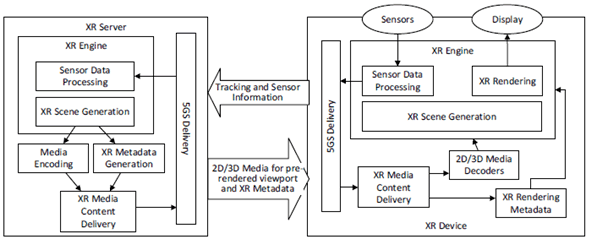
An XR client may have following capabilities.
- XR capture
- Sensor data processing (e.g., AR pose tracking)
- XR scene generation
- XR rendering.
- 2D or 3D Media decoding
- Metadata (including scene description) processing
- 5G delivery
- Sensor data processing
- XR scene generation
- 2D or 3D media encoding
- Metadata (including scene description) generation
- 5G delivery
6.2.8 XR Conversational p. 72
In Figure 6.2.8-1, a general architecture for XR conversational and conference services is depicted. As stated, these services are an extension on the current MTSI work, using the IMS for session signalling. In order to support XR conversational services (in 5G), extensions are needed in the signalling to enable VR/AR specific attributes, and the media and metadata need to support the right codecs, profiles and metadata. A new interface is the interface to the network (based) media processing. This is an interface similar to that to an SRF, but is expected to be much more extensive to support various types of media processing. This interface can be based on the work in MPEG on Network Based Media Processing.
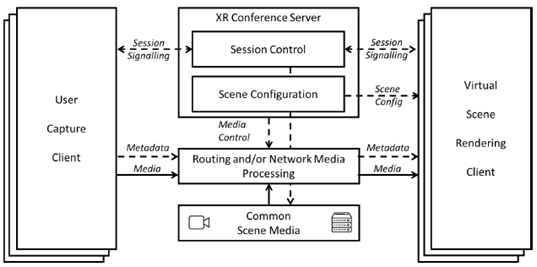
Figure 6.2.8-1: General architecture for XR conversational and conference services
(⇒ copy of original 3GPP image)
(⇒ copy of original 3GPP image)
Typical steps for call session setup follow normal IMS procedures, in case the clients have a simple peer-2-peer call and also do all processing themselves (simplified procedure as follows):
- The first client initiates call setup (SIP INVITE);
- The IMS (i.e. central session control) routes the call setup to the second client, ensuring proper bandwidth reservations in the network;
- The second client, after call acceptance, responds to the call setup (200 OK);
- The network controls all bandwidth reservations;
- Call setup is completed.
- Foreground/background segmentation;
- HMD removal, i.e. replacing a users HMD with a 3D model of the actual face, possibly including eye tracking / reinsertion;
- 3D avatar reconstruction, i.e. using RGB + depth cameras or multiple cameras to create 3D user video avatars;
- Support for multiple users with a (centralised or distributed) VR conferencing bridge, stitching multiple user captures together;
- Creating a self-view, i.e. local 3D user avatar from the user's own perspective.
- First a client initiates the call setup;
- Based on the call setup, the session control triggers network based media processing, reserves resources in the network, incl. media processing resources;
- Session control forwards call setup to the second client;
- After call acceptance, both first and second client are connected to the network processor.
- Session control instruct the network processor on the actual processing and the stream forwarding, i.e. which input streams go to which clients.
- placement of media processor: central vs edge, centralised vs distributed.
- delay aspects for communication purposes. Ideally, delay is kept to a minimum, i.e. <150 ms one-way delay. Given the required processing, this is a challenge, and will effect e.g. codec choices and rendering choices.
- 2D+/RGBD: >2.7Mbit/s (1 camera), >5.4Mbit/s (2 Camera)
- 3D Mesh: ~30 Mbit/s
- 3D VPCC / GPCC: 5-50 Mbit/s (CTC MPEG)
6.3 Summary of Traffic Characteristics p. 74
This clause summarizes initial typical traffics characteristics for different architectures, based on the findings in this clause. The parameters relate to the 5G PDU session QoS as introduced in clause 4.3.
Table 6.3-1 provides initial traffic characteristics for different architectures based on the findings in clause 6.2. Whereas some initial aspects are collected, many issues are FFS.
Legend:
- DL: Downlink,
- UL: Uplink,
- PDB: Packet delay budget,
- PER: Packet Error Rate,
- RTT: Round Trip Time
| Architecture | DL Rate range | UL Rate range | DL PDB | UL PDB | RTT | DL PER range | UL PER range | Traffic periodicity range | Traffic file size distribution |
|---|---|---|---|---|---|---|---|---|---|
| Viewport independent streaming | 100 MBPs | HTTP requests every second. TCP handshake | See adaptive streaming | See adaptive streaming | See adaptive streaming and TCP equation | 10e-6 | 10e-6 | Almost constant | Almost constant |
| Viewport dependent streaming | 25 MBPs | More frequent HTTP requests every 100ms. TCP handshake | See adaptive streaming | See adaptive streaming | See adaptive streaming and TCP equation | 10e-6 | 10e-6 | Almost constant | Almost constant |
| Viewport Rendering in Network case 1 | 100 MBit/s | FFS | FFS | FFS | FFS | FFS | FFS | FFS | FFS |
| Viewport Rendering in Network case 2 | 1 GBit/s | FFS | FFS | FFS | FFS | FFS | FFS | FFS | FFS |
| Viewport Rendering in Network case 3 | 10 Gbit/s | FFS | FFS | FFS | FFS | FFS | FFS | FFS | FFS |
| Raster-based Split Rendering with Pose Correction | 100 Mbit/s | 500 kbit/s | 20ms | 10ms | 50ms | FFS | FFS | Almost constant | FFS |
| Generalized Split Rendering | FFS | FFS | FFS | FFS | FFS | FFS | FFS | FFS | FFS |
| XR Distributed Computing | FFS | FFS | FFS | FFS | FFS | FFS | FFS | FFS | FFS |
| XR Conversational | FFS | FFS | FFS | FFS | FFS | FFS | FFS | FFS | FFS |
| XR Conferencing Details are FFS | 3Mbit/s up to 50Mbit/s per user | 3Mbit/s up to 50Mbit/s | Allowing real time communication | Allowing real time communication | Allowing real time communication | FFS | FFS | almost constant (with peek during start-up) | > 50Mb at the beginning, depending on media consumption no or almost constant |
6.4 Analysis of existing 5QIs p. 75
As a summary of the above, existing 5QIs may be used for adaptive streaming over HTTP applications as defined in clause 6.2.2 and 6.2.3.
For other types of services, new 5QIs for Uu-based communication are considered beneficial, among others
- If other protocols than adaptive streaming over HTTP would be applied, then suitable 5QIs would be for FFS.
- New 5QIs and QoS support in 5G System for network and split rendering addressing latency requirements in the range of 10-20ms and bitrate guarantees to be able to stream 50 to 100 Mbps consistently
- More flexible 5QIs and QoS support in 5G System for generalized split rendering addressing differentiated latency requirements in the range of 10ms to several 100ms and with bitrate guarantees.
- Error rates are FFS.
- The data rate, latency and PER for different architectures as introduced in clause 6.3 are FFS.